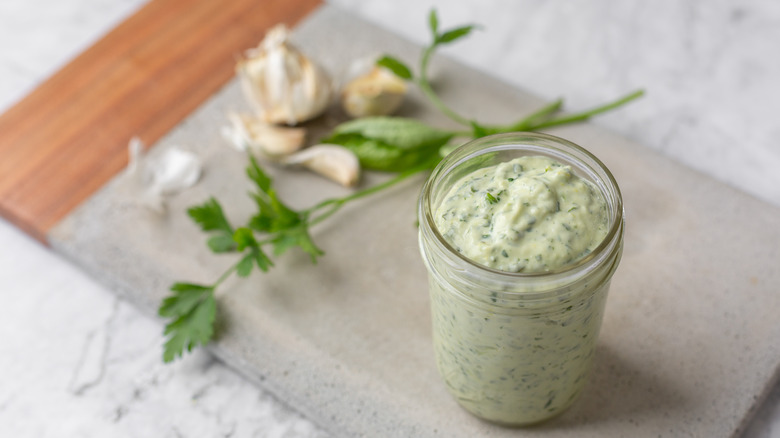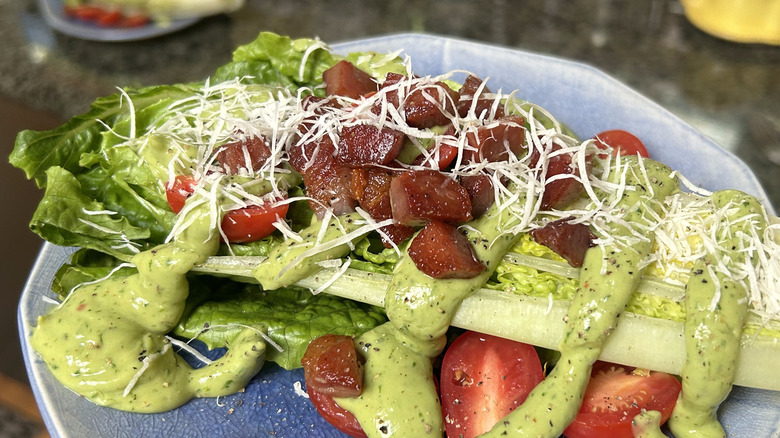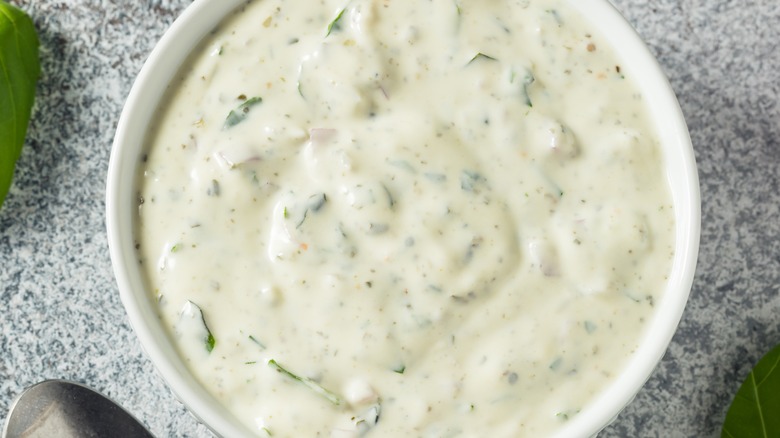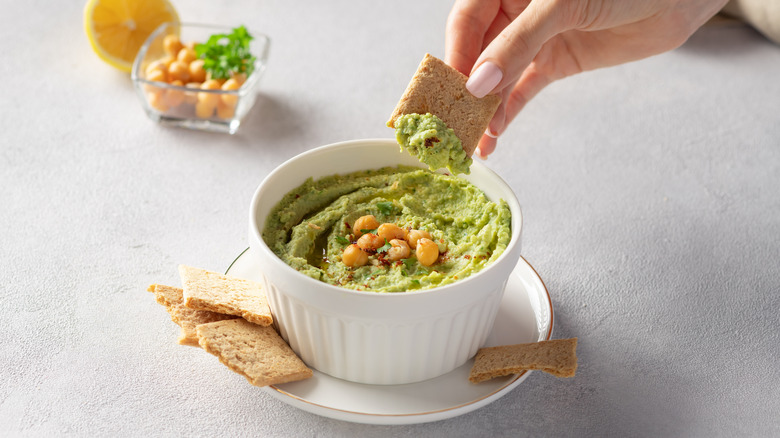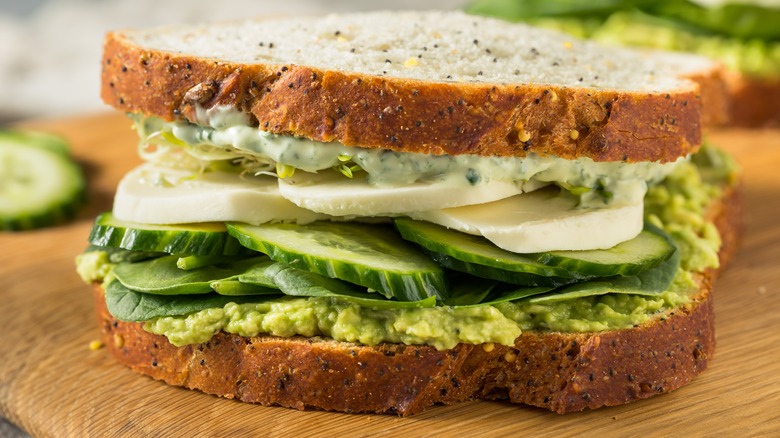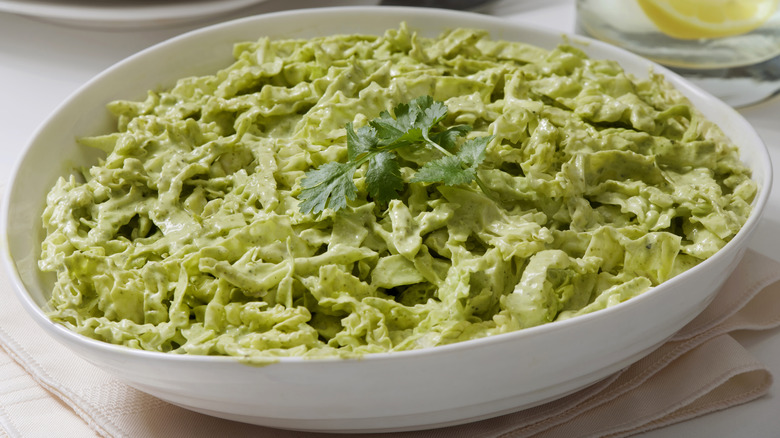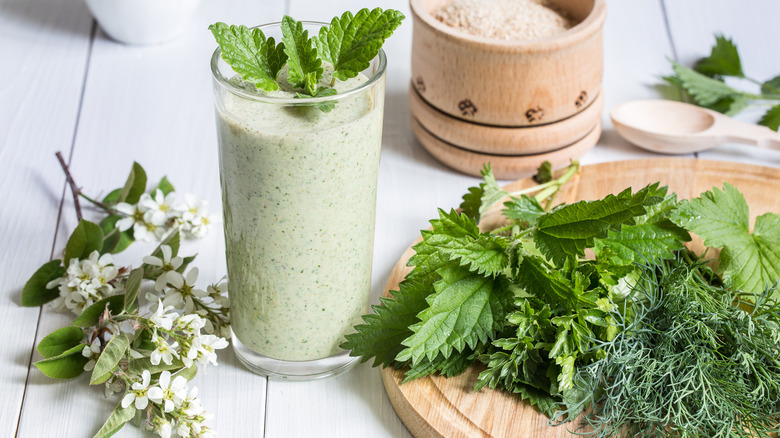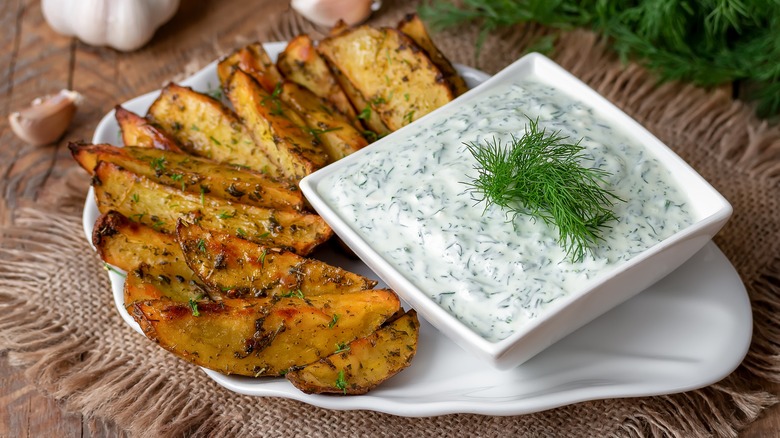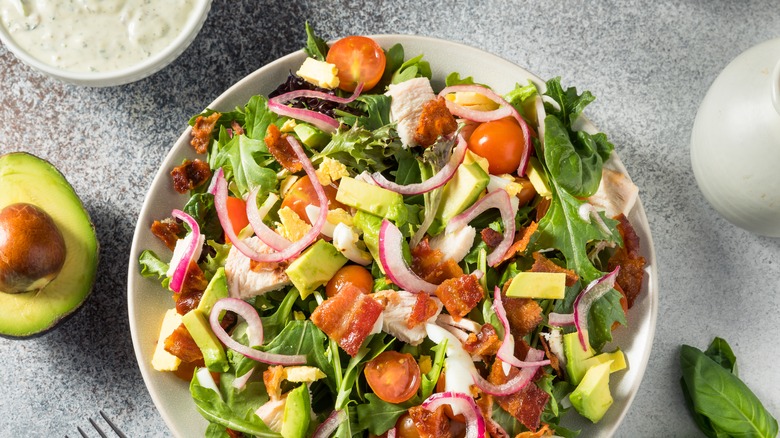Why You Should Get Creative With Green Goddess Dressing, According To A Plant-Based Chef
Green Goddess dressing is a tangy, creamy, and herbaceous sauce with a fresh Midas touch that can turn any food into green gold. This beloved blended condiment is currently considered a staple sauce in and around California's Central Coast and is especially in demand during the spring and early summer months when fresh herb supplies are in season. The origin stories trace the creation of Green Goddess dressing back to San Francisco's Palace Hotel in 1923, though the current Green Goddess recipe renditions are almost countless.
See, Green Goddess dressing has a reputation as a versatile and ever-evolving dish, due in part to the wide array of creative culinary applications that continue to make it an invaluable addition to any kitchen's recipe Rolodex. The sheer number of unique twists, turns, and tastes that Green Goddess can bring to the table explains away the popularity of this particular salad dressing.
To help get some springtime inspiration in the kitchen with Green Goddess dressing is chef Katie Reicher, the executive chef at San Francisco's own renowned Greens Restaurant. Greens is among San Fran's most legendary restaurants and is known for its innovative approach toward vegetarian dishes. Chef Reicher is no stranger to getting creative with greens in the Greens kitchen, and her Green Goddess hummus recently made its mark across the culinary community. And, luckily, she agreed to an interview to share some truly inspired tips, tricks, and techniques that'll have everyone worshipping the creative freedom and flavors of Green Goddess dressing.
What is Green Goddess dressing?
If a vibrant salad dressing, packed with fresh herbs and complimented by a medley of zingy, creamy, and bright ingredients blended into one mouthwatering yet surprisingly nutritious sauce sounds appealing, Green Goddess is for you. At its core, Green Goddess dressing is comprised of fresh, local herbs like dill, chives, cilantro, parsley, basil, tarragon, mint, and chervil. To make a typical Green Goddess dressing, these herbs are blended with other things like sour cream, avocado, mayo, anchovies, and more. Because of the variety of ways Green Goddess dressing may be used to enhance a dish, its greatest asset is its versatility. The creative applications of Green Goddess are as boundless as the imagination of the person behind the blender.
The base ingredients used in most Green Goddess dressings can diverge depending on the cook, individual dietary needs and preferences, and the recipe's era (a lot can change in 101 years, including dressings). But this changeable quality is Green Goddess dressing's greatest culinary strength. Green Goddess recipes can easily switch between pescatarian, vegetarian, or vegan with only a few alterations. The oldest recipe, for instance, calls for mayonnaise and anchovies with vinegar. However, many modern Green Goddess interpretations feature avocados, lemon juice, and sour cream but are less likely to contain anchovies. The only constant in Green Goddess recipe renditions is in the herbs, though even those are up to location, season, and interpretation.
Green Goddess dressing is a quality blender sauce
Versatile recipes such as Green Goddess dressing are amazing to have stashed away in your recipe Rolodex. And though this fresh dressing tastes equally amazing when made in a million different ways in a ton of different dishes, that wide array of culinary creativity does not mean you can forget all technique and reason coming into the kitchen. So, what's most important to keep in mind when working with Green Goddess dressing and its versatile ingredients? Well, Reicher has only a few definite don'ts when it comes to working with this verdant dressing.
"I don't think there's much that can go wrong — it's mostly a blender sauce," said Reicher. "The one thing I might warn against is to use a sharp knife when chopping herbs, and don't overprocess them because then it can turn brown. But if you blend and stop as soon as it's emulsified, then you shouldn't have a problem." Also, the possible dairy and probable avocado in your Green Goddess dressing are both ingredients that can create culinary catastrophe rather than delicious salad dressing when only one thing is added: heat. "Definitely don't add [Green Goddess dressing] to hot stuff," Reicher warned.
It gives fresh flair to hummus
Green Goddess hummus is Reicher's own creation, the same one that swept the culinary world by storm after she developed and released her own recipe at Greens during the start of her career shift to executive chef. "Looking back, I'm like well of course it sold really well because it's dill and avocados and fresh lemon, and what I thought was a weird thing before is actually so, so bright and fresh and springy — so we love using Green Goddess."
Inspired by the trending Green Goddess dressing and due to the plethora of fresh, in-season herbs she had access to, Reicher created an accidental culinary sensation that Californians, New Yorkers, and food lovers all across the globe absolutely adore. "To this day, I have never had a dip or spread go so... I don't want to use the word viral, but it was almost like every table was getting it," said chef Reicher. "I'm stubborn and I don't want to repeat dishes every single year because I want to make room for new stuff, but the Green Goddess hummus is one that people always ask me about and ask for the recipe for, so I'm publishing it in my cookbook that's coming out next spring."
Enhance spreads with its herbaceous flavor
If you want to use Green Goddess dressing in creative ways this season, consider using it (or its base ingredients) in a wide variety of spreads. Green Goddess dressing perfectly suits most spreads due to its creamy, smooth nature, which matches the qualities most sought in spreads.
Spreads are often seen on sandwiches, though they can be used creatively in, on, and under many dishes to add texture, flavor, freshness, unctuousness, and other desirable elements to dishes. Aside from using a Green Goddess spread on sandwiches, you can also combine the sauce with purées and add tasty meats, veggies, and other foods on top for a new hybrid. "I did a buttered cabbage dish with a Green Goddess cashew spread with a farro salad," said chef Reicher. "It wasn't quite 'The Dressing,' but it was this herbaceous sauce that went with this rich buttery cabbage."
Create a Green Goddess-inspired pasta
Green Goddess pasta is perhaps the most crowd-pleasing, popular application of the original Green Goddess dressing. This rich, carby, and filling dish is the perfect place to include all those fresh herbs and let their lighter qualities as ingredients shine. "Besides using it as a dressing, a cream, or a hummus, I think you can use those flavors and that kind of creamy idea in a lot of different things. Maybe omit the avocado... and use the same herbs and lemon and maybe the anchovy (if you eat anchovy, but if not leave it out) to a pasta — why not? Yeah, I think that would be awesome," added Reicher.
If you plan on getting creative with some Green Goddess pasta, Reicher's only advice is to make some small alterations in consideration of the inherent heat of many pasta dishes "I'm not suggesting you throw Green Goddess [dressing] into a pasta, but make a Green Goddess-inspired dish," Reicher clarified. "Substitute the mayo for a little lemon butter, then you have a Green Goddess-inspired pasta."
A Green Goddess marinade can add flavor and tenderize meats
Another idea for incorporating Green Goddess dressing into a creative dish is to take a whole lot of its base ingredients and turn them into a marinade for meat, tofu, and whatever other meals take well to soak up flavor before cooking. Reicher suggests getting inspired by the Green Goddess concept or its ingredients and putting them in your marinate. Not only will this translate deliciously, but it can also create more flavorful dishes when fresh herbs are layered in with more developed components, like those found in marinades. "I think you could make a marinade off of Green Goddess; same kinda deal," said Reicher. "Maybe omit the mayo and use olive oil or something if you want it to be lighter, but I don't know, I think mayo is actually a kinda good tenderizer."
Mayonaisse, for those who don't know, works very well to tenderize meats. Surprisingly, this divisive condiment can also add to the Maillard reaction, which means any meats marinated with mayonnaise can benefit doubly by becoming extra tender while developing a better, faster crust, which could lock in moisture and make for an unforgettable eating experience.
Get creative with refreshing Green Goddess cocktails
Cocktails are the ideal vessel for creative chefs and cooks alike, especially those who find themselves wanting for a low-stakes, high-reward recipe of the beverage variety that can carry savory and sweet verdant flavors with equal vigor. If you're one of those experimental culinary archetypes, looking for innovative ways to play around with different methods of incorporating fan-favorite flavor combinations. Whether you want to use a few or a fair few of the Green Goddess dressing ingredients in your cocktail, you can absolutely do so — and have a blast messing around with ratios, combinations, textures, and personal culinary flairs to each and every drink.
"I honestly wouldn't be surprised if you could throw it in a cocktail," said Reicher. "Like a dill-y cocktail. Dill and lemon... mint." Reicher's suggestion for using Green Goddess ingredients to inspire a cocktail is to lean into the inherent freshness and to utilize enough lemon to really add an acidic balance to whatever beverage calls to your creative instincts. "Why not make a margarita?" asked Reicher.
Green Goddess ingredients can amp up mayo dips
In the vast, seemingly endless sea of creative ways to use Green Goddess sauce, dips are perhaps the most simple, easy, and versatile of them all — especially when it comes to one popular condiment: mayonnaise. This incredibly common spread is one that lends itself to just about any flavor you want, which is why you'll see every flavor from smoky paprika to garlic to Green Goddess blended into one smooth and delicious dip. You can even add some mustard for extra tang.
"Green Goddess mayo..." Reicher mused. "Just make it less of a dressing and a mayo dip." For those who enjoy french fries, chips, and healthier veggie alternatives, a Green Goddess-inspired mayo dip could be the perfect in-between that keeps a seasonal twist to those springtime mayo-based sauces. And since a whole lot of Green Goddess recipes already include mayonnaise, there's no learning curve when it comes to incorporating more of that particular ingredient into your favorite verdant dressing recipe.
The Green Goddess salad is classic and customizable
Using Green Goddess dressing as a salad condiment may not break any creative glass ceilings, but classics are classics for a reason. And Green Goddess goes with greens underneath so well that even the latest TikTok trends agree. All those delicious green herbs, healthy fats from the avocado, and generally fresh flavors compliment a classic, crisp salad so well that the only thing left to do is decide what else to add to that salad to make it really shine.
"Even if it's just crispy little gems with 'The Dressing,' that should be enough, honestly. You want that lettuce that almost bursts with juice when you bite into it. The one that's just so, so crispy, and pair it with that creamy, herby Green Goddess. I mean, what else do you need?" Reicher said. Whatever you want to put into the salad underneath all that Green Goddess, Reicher suggests keeping things simple, light, and equally fresh. "But if you do want to make a salad with more stuff in it, I would stick to fresh, bright cherry tomatoes, radishes, snap peas — oh my god, snap peas would be so good," she added.
"Potatoes! Oh my god, make a potato salad!" Reicher exclaimed shortly after. She later built on that epiphany through a post-interview email. "I keep thinking about that Green Goddess potato salad idea... might need to do this for the spring menu!"
